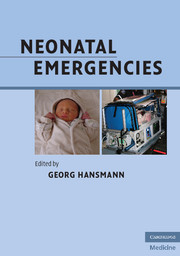Book contents
- Frontmatter
- Contents
- List of contributors
- Foreword (1)
- Foreword (2)
- Preface
- Acknowledgments
- Section 1 Organization of neonatal transport
- Section 2 Basics in cardiopulmonary resuscitation of newborn infants
- Section 3 Classic and rare scenarios in the neonatal period
- Management of healthy, term newborn infants (vaginal delivery, cesarean section, vacuum extraction, forceps delivery)
- Management of preterm and moderately depressed term newborn infants with a birth weight ≥1500 g
- Management of very preterm newborn infants (VLBW, ELBW)
- Twin–twin (feto–fetal) transfusion syndrome
- An apparently trivial call from the term baby nursery
- Out of hospital birth
- Hypoglycemia
- Meconium aspiration
- Chorioamnionitis and early-onset sepsis in the newborn infant
- Perinatal hemorrhage
- Perinatal hypoxia-ischemia
- Cerebral seizures
- Infants born to mothers on psychoactive substances
- Prenatal and postnatal arrhythmias
- Critical congenital cardiovascular defects
- Patent ductus arteriosus of the preterm infant
- Persistent pulmonary hypertension of the newborn (PPHN)
- Congenital diaphragmatic hernia
- Pneumothorax
- Congenital cystic adenomatoid malformation of the lung (CAM, CCAM)
- Chylothorax
- Hemolytic disease of the newborn
- Hydrops fetalis
- Choanal atresia
- Esophageal atresia
- Gastrointestinal obstruction
- Necrotizing enterocolitis (NEC)
- Omphalocele and gastroschisis
- Neural tube defects
- Cleft palate
- Birth trauma: brachial plexus palsy, facial nerve palsy, clavicular fracture, skull fracture, intracranial and subperiosteal hemorrhage (cephalohematoma)
- Sudden infant death syndrome (SIDS)
- Questions for review
- References (Section 3)
- Section 4 Transport
- Section 5 Appendix
- Index
- Plate section
Perinatal hypoxia-ischemia
from Section 3 - Classic and rare scenarios in the neonatal period
Published online by Cambridge University Press: 05 March 2012
- Frontmatter
- Contents
- List of contributors
- Foreword (1)
- Foreword (2)
- Preface
- Acknowledgments
- Section 1 Organization of neonatal transport
- Section 2 Basics in cardiopulmonary resuscitation of newborn infants
- Section 3 Classic and rare scenarios in the neonatal period
- Management of healthy, term newborn infants (vaginal delivery, cesarean section, vacuum extraction, forceps delivery)
- Management of preterm and moderately depressed term newborn infants with a birth weight ≥1500 g
- Management of very preterm newborn infants (VLBW, ELBW)
- Twin–twin (feto–fetal) transfusion syndrome
- An apparently trivial call from the term baby nursery
- Out of hospital birth
- Hypoglycemia
- Meconium aspiration
- Chorioamnionitis and early-onset sepsis in the newborn infant
- Perinatal hemorrhage
- Perinatal hypoxia-ischemia
- Cerebral seizures
- Infants born to mothers on psychoactive substances
- Prenatal and postnatal arrhythmias
- Critical congenital cardiovascular defects
- Patent ductus arteriosus of the preterm infant
- Persistent pulmonary hypertension of the newborn (PPHN)
- Congenital diaphragmatic hernia
- Pneumothorax
- Congenital cystic adenomatoid malformation of the lung (CAM, CCAM)
- Chylothorax
- Hemolytic disease of the newborn
- Hydrops fetalis
- Choanal atresia
- Esophageal atresia
- Gastrointestinal obstruction
- Necrotizing enterocolitis (NEC)
- Omphalocele and gastroschisis
- Neural tube defects
- Cleft palate
- Birth trauma: brachial plexus palsy, facial nerve palsy, clavicular fracture, skull fracture, intracranial and subperiosteal hemorrhage (cephalohematoma)
- Sudden infant death syndrome (SIDS)
- Questions for review
- References (Section 3)
- Section 4 Transport
- Section 5 Appendix
- Index
- Plate section
Summary
Definition
“Asphyxia” (Greek: stopping of the pulse), i.e., the biochemical and clinical consequences of lack of oxygen and hypercarbia following antepartum or intrapartum interruption of respiration/perfusion. In addition to hypoxia, there is respiratory and metabolic acidosis that can lead to peripheral and pulmonary vasoconstriction and ultimately, if untreated, to myocardial failure, hypotension, and bradycardia.
The term “perinatal asphyxia” should be used with constraint, not only for medical-legal reasons, but also due to the lack of a broadly accepted definition. According to Carter et al. (1993), perinatal asphyxia is defined as a combination of:
Severe umbilical arterial acidosis with a UA pH value <7.00
Persistently low Apgar score <4 for at least 5 min after birth
Neurological symptoms, such as seizures, unconsciousness or muscle hypotonia, and
Cardiac, pulmonary, intestinal or renal dysfunction
The American College of Obstetrics and Gynecology defines an acute intrapartum hypoxic event meeting the following combined criteria as sufficient to cause spastic quadriplegic or dyskinetic cerebral palsy:
Severe umbilical arterial acidosis with a UA pH value <7.00 and base deficit ≥12 mmol/l
Early onset of moderate to severe encephalopathy in an infant ≥34 weeks' gestation
Exclusion of other identifiable etiologies
! It is inappropriate to use the term “birth asphyxia” based on a single low Apgar score or a single low pH value (obtained from the umbilical artery) in the absence of neurological signs or symptoms.
Epidemiology
Delayed postnatal adaptation occurs in approx. 5%–10% of all births; thus, in about 2–3/1000 births, birth asphyxia is possible.
Etiology/pathophysiology
Impairment of the feto–placental gas exchange:
Preplacental: lack of oxygen supply due to uterine rupture, maternal anemia, shock, embolism, sepsis, respiratory insufficiency, or conditions causing chronic placental insufficiency
[…]
- Type
- Chapter
- Information
- Neonatal Emergencies , pp. 310 - 316Publisher: Cambridge University PressPrint publication year: 2009



